Arctic Awakening
by Bethan Evans, Researcher, Arctic and Mountains team
I’ve recently returned from my last Arctic filming trip for Human Planet. My amazing year and a bit in the North culminated with an encounter with a majestic animal known as the King of the Arctic.
The shoot was in the town of Churchill which is also known as the “Polar bear capital of the World”. The town is built near to an ancient polar bear migration route. Each autumn polar bears gather nearby, waiting hungrily for the sea ice to reform so they can get back out to their hunting ground. Forced onto land during summer due to the melting ice the bears have not eaten anything substantial for months. So who can blame them when they wander into the town enticed by the lovely food smells that are produced by restaurants or even the bins and rubbish dump!
We were there to film how people carry on their daily lives, when for several weeks of the year, there is a real possibility of coming face to face with the only land animal that is known to actively predate on humans! Luckily there is a specialist protection team set up in Churchill called the Polar Bear Alert. These guys work tirelessly, in the most unique way, to ensure that the both bears and people are safe and unharmed – watch the full story in Human Planet: Arctic programme in 2011!
The Polar Bear is an icon – a majestic animal that’s revered but also feared, a symbol of a lost wilderness. I felt so privileged to have the opportunity to see these incredible animals. So it was a shock when it finally dawned on me that my first chance to see a Polar Bear in the wild might also be my last. I’m so used to seeing images of the Polar Bear whether it be in Hollywood films, marketing campaigns for soft drinks or even Christmas cards. They somehow make these Arctic dwellers seem abundant but of course the sad fact is they’re not.
Climate change is causing a vast reduction in sea ice and therefore a loss of natural habitat for the polar bears which, in time, will lead to their demise in the wild. With this realisation I began to think of all the different Arctic people I have met on my Human Planet journey. If climate change continues at its current rate what will happen to them? How will Amos the Greenlandic fisherman make a living from fishing at winter ice holes when the ice isn’t thick enough to support him? How will Lukasi and Mary go under the ice to collect mussels when they can no longer predict how the ice will behave?
The Arctic people I have met are incredibly adaptive – their way of life has changed drastically in the space of one generation. Many people have the ability to take the best from western technology and adapt it to work with traditional knowledge. However, Arctic peoples are inextricably connected to the landscape - a change in their environment impacts on every aspect of their lives. This isn’t something that is going to happen in the future, it is happening right now.
The good news is that it’s not too late to slow down or prevent the negative impacts of climate change not only for Arctic Peoples and animals, but for all of us. Small measures from you and me can make all the difference. Take a look at these two BBC sites for more information http://www.bbc.co.uk/climate/ and http://www.bbc.co.uk/bloom/
Making this series has really raised my awareness of the incredible variety of cultures and wildlife that the Earth sustains. I hope that if I can change my ways the first time I see a polar bear won’t be my last and the environmental impact on Arctic peoples lives will be minimal.
A Year on Human Planet
by Willow Murton, Assistant Producer, Oceans/Jungles team
9th October 2009
This time a year ago, I flew to La Paz in Bolivia, the highest capital city in the world and there, short of breath and cheeks full of Andean colour, I began life on the Human Planet team. I type this blog now under the stifling heat of the Algerian Sahara, many miles from those early cool heights.
Sometimes it is good to stop and reflect. There has not been much time over the last year for moments to look back – so much looking forward into the matrix of kit lists, itineraries and budgets that the months and the countries can go by.
This October evening, we gathered on a carpet outside under the date palms and the eager gaze of the local well workers who we have been filming with. Swirls of white turbans and the excited movement of children surround a small screen as we play out clips of what we have filmed over the last few days. They watch the images and the sounds they have patiently repeated in order to get just the right shot, in the right light. They laugh and we relax. This is one of the best moments of film-making, sharing the work of crew and contributors. We hope all our ridiculous demands make some kind of sense when seen on screen, and we too begin to understand more as questions bounce between us.
The claustrophobia of the small tunnel where we have been filming opens out into the warm evening. Small glasses of sweet mint tea are passed about amongst the comments. Filming is a demanding and long process which the workers have participated in with huge patience and good humour. In order to give them a glimpse of how the final film may come together, as well as a chilly insight into another underground world, we put on an edit from an Arctic sequence. There we are, warm in the evening air, watching people wrapped up from icy cold. There are gasps when I say that the temperature there is thirty degrees below Celsius. The days here in the desert are usually thirty degrees above and not unusually much higher. Beneath the arid surface of the Sahara, the workers here have dug through thick red clay to make tunnels to feed an ever-growing irrigation system. They cannot believe the effort of these distant Arctic dwellers as they dig into frozen crevasses. They are even more incredulous when they realise why. What the Inuit consider a gastronomic delicacy, the workers of the Sahara struggle to imagine edible. The frozen walls of an igloo protecting those inside from the cruel cold of the Arctic belong to another world, far from the rich red buildings of this small village, where people seek shade from a relentless burning sun.
Yet, further North, the Arctic is beginning its own dark turn to the winter once more. This year on Human Planet has spanned continents and captured moments of incredible feats, emotion and beauty. As the workers leave to sleep before they are called to prayer again and back to their work, I contemplate a year which has taken me to a frontline in the Simien mountains, above Greenlandic glaciers, into the path of avalanches, under sea ice and onto its floe edge, from Arctic darkness to midnight sun, from the green of a desert oasis to the barren hillsides of a Caribbean island. Like the Andean heights where I began, it takes my breath away.
Land of the midnight sun
by Willow Murton, Assistant Producer, Arctic/Mountains team
“Wake up Willow!” shouts a voice.
I pull off my eye mask and open my eyes. The sun shines bright above me. I look at my watch. Three o’clock in the morning? I sit bolt upright, lifting my head from the make do pillow. Reindeer hair sticks to my cheek. Simon the sound recordist mutters as he rigidly stares out ahead of us. Beth the researcher alongside us is, like me, struggling with sleep deprivation and the daylight. I am still trying to focus my eyes in the dazzling night of the Arctic summer. Suddenly I see the figures along the ice edge. Five men, spread out along the horizon, all poised, waiting…watching for their target.
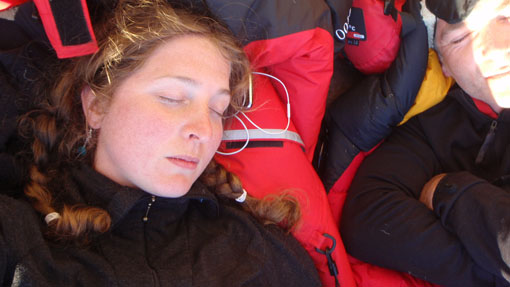
Simon (Forrester) and I just before our sudden awakening
Simon swears. We aren’t hunters but we know the rules. We mustn’t do anything, we mustn’t move, cannot move from our dogsled bed. I spot our tripod and camera, no cameraman anywhere nearby. I am filled with a dreadful nauseous realisation – this could be the moment that we have spent over a year working towards. Months of careful negotiations and awkward logistics all for us to sleep through our only possible chance of filming a narwhal hunt. We can only sit and watch in confused disbelief… At that moment, the silhouette of a whale crests the ice edge. I wonder how on earth I am going to explain this to the team back in Cardiff…
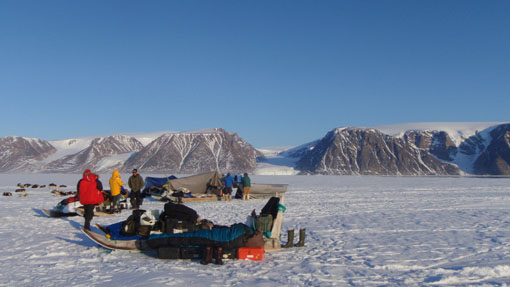
Our camp
Surreal scenes like this are surely what you are supposed to wake from rather than wake up to. It’s late Spring in Northern Greenland , there is no reference to time as the sun never sets so the days blend into each other. In the full glare of the midnight sun this is a place where anything seems possible and where dreaming and being seem to meet.
The landscape itself is constantly changing as the sea ice melts and the winds reshape it continually. One morning it is a distant horizon and the next it reappears broken against the floe edge like shattered glass. Weeks of watching ice charts are no preparation for what life on the ice demands. We are four hours from the town of Qaanaaq and a world away from the scientific maps of metereology. The brothers we are filming read the ice because they have learnt that their lives depend on it.
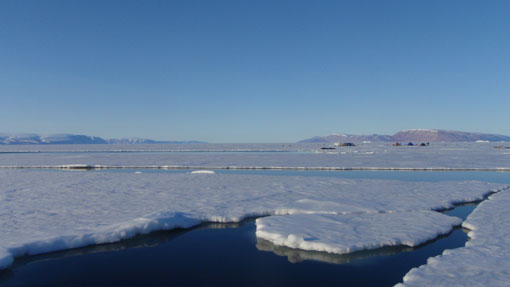
Our camp in the distance beside the melting ice edge
Our camp of six sleds is set on a floating platform of ice, around five metres thick. We must always be ready to move in case the ice cracks and we find ourselves adrift in the freezing Arctic Ocean. All the hunters have a warning tale to tell. We live between the anxiety of the hunt and the ice watch and the monotony of no day and night and the constant of rehydrated food rations. We put sun cream on at two in the morning and wear sunglasses in our sleeping bags. We laugh with the hunters, with each other, to ourselves. We develop our own ways of dealing with the daylight and the long hours of nervous despair waiting for invisible whales to return.
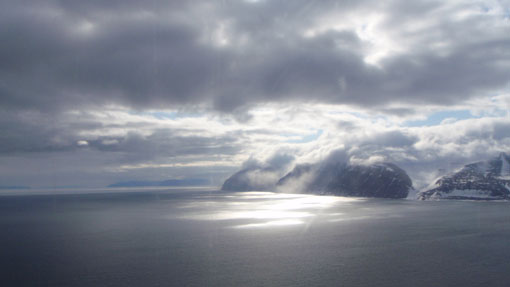
A surreal, ever-changing landscape
What happened next after that first daylit night on the ice edge, only the film can tell. Finally coming back to the predictable shades of the British summer was itself like awakening from a distant dream.
Dale Templar - Series Producer
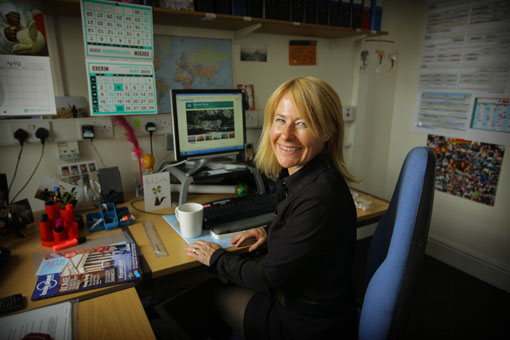
I think I have already moaned about the British Summer in an earlier blog, and believe me it’s easy to moan. Reading Willow’s account of summer life in Greenland does make we remember how lucky we are here in the UK. Living with 24 hour sunlight is really strange and does mess with your head and sleep patterns. I was lucky enough to spend time in Antarctica filming penguins - the cameraman and I had to wait until 3.30am to film the sunset! The flip side however is far worse; there are many communities in the Arctic as well as the scientists down South, who have to spend months of the year in total darkness. That would totally do my head in! I would suffer from SAD (Sunlight Affective Disorder) and seriously go mad!
I was talking this week to a producer from Glasgow. Apparently SAD is a real problem there and the Scottish Government is considering handing out vitamin D to people because of the lack of sunlight in the winter months. So, can you imagine what it must be like in Greenland? Anyway, I’m looking forward to viewing footage from central Africa next week. Now there’s a great place to be, 12 hours of darkness and 12 hours of sunshine, the perfect mix for film makers.
Teams everywhere on location
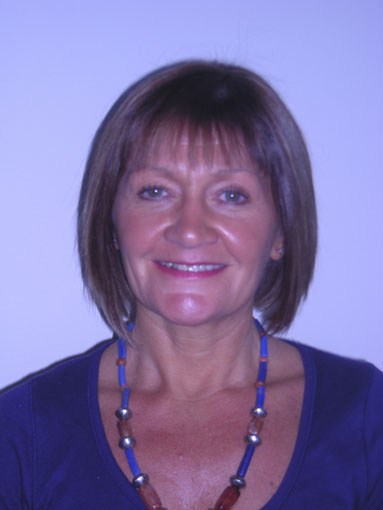
by Ellen Davies, Production Manager, Arctic/Mountains team
My location is Cardiff and my office is on the top floor of BBC Wales which overlooks Llandaff Cathedral. Here I enjoy the comforts of my work place where so many of our day to day facilities are taken for granted. I’m comfortable. One of my teams are currently in Greenland, the other is about to head off to Mongolia (for more see below my blog). Geoff from BBC Shipping has a very soft, gentle voice and says: “Calm. Calm.” It works. I’m now calmer and I’m in the process of freighting my second shipment of kit to Qaanaaq, the most northern town in Greenland. Geoff simplifies the process.
We hire, purchase, gather and pack our kit with our wonderful Patrick Murray, Cardiff’s Technical Assistant on Human Planet (what would we do without Patrick?). For Greenland this includes a crane with hothead, a kayak with specially designed rig, camping gear, cameras, sound, first aid kit and enough warm clothes and sleeping bags to make sure the crew don’t freeze.
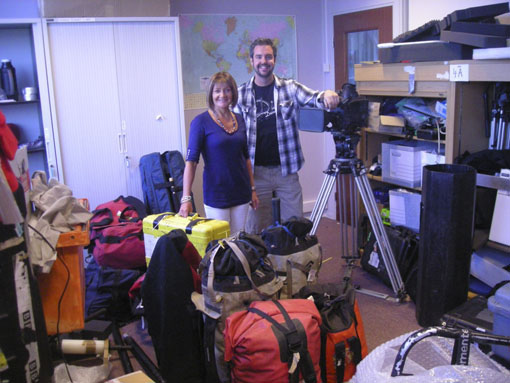
Ellen and Patrick and kit bound for the Arctic
Getting the kit to our destination is quite straightforward – from Heathrow to Copenhagen to Kangerlussuaq to Illulissat to Pituffik to Qaanaaq and onto Siorapualuk. Easy. (I can even pronounce these names now!) The kit gets there. It takes two days. The last ride is by helicopter where you would fly along the rocky coast line over icebergs and fiords. It must be pretty spectacular. The third shipment of kit travels with the crew and I’ve only booked a seven seater people carrier to transport three people and kit! Where and how do we accumulate so much? We’ve now exceeded over 1000 kgs of kit. The Arctic crew are out of the door and I’m already on the next shoot for the Mountains programme….
My Greenland team are filming two stories for the Arctic episode and one involves filming on sea ice that is starting the break up. Because of the dangers of trying to film the narwhals (sea unicorns) from the kayak and on the ice edge, we have a strict protocol – Bethan Evans (researcher) or Nicolas Brown (producer/director) must call me at 16.00 hrs daily. If I don’t hear from them after four hours, I then make contact to their local police. I look forward to my cup of tea after I’ve received their phone call. I can relax for another day. My schedule and two mobile phones rest on my bed side table and I warn my husband that I might just get a call. I put my phones on silent but vibrate.
Sometimes I wish I was the one going on these amazing filming trips but generally I enjoy being on the end of a satellite phone, the welcome voice of home for the guys on location. By working on this series I’ve really come to understand the incredible way people live in these remote environments. More than ever I appreciate the comforts of my home, my family and friends and the BBC office. Roll on 2011, when I will enjoy watching the fantastic footage and amazing stories on my 52” plasma screen in HD!
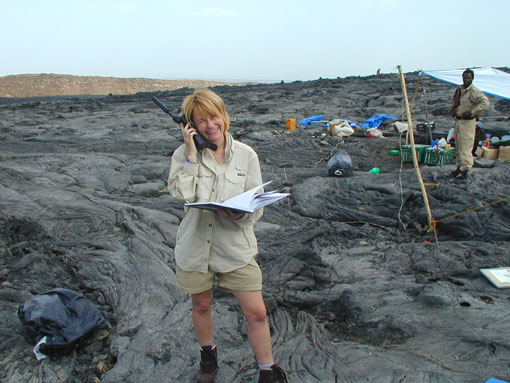
Dale Templar, Series Producer, A Return to the Last Disco in Mongolia
I don’t get out much these days, one of the few down sides of running Human Planet. On Sunday I am due to return to Mongolia to film golden eagle nests. I say “due” because I’ve just had a phone call from Dina, our researcher, to say the eagle chicks we wanted to film have been taken! Poor Dina! As I write, there are men on horses galloping around the western Mongolia mountains looking for eagle nests. They are seven hours ahead and if there is no joy soon we may have to cancel the shoot.
Anyway, back to my original story. If we do fly on Sunday this will be a strange return. The last time I filmed in Mongolia was in 1993, soon after Russia pulled out of the country. It ‘s still one of the most God forsaken places I have ever visited. The economic rug had been pulled from underneath the country - they’d been left abandoned. Ulaanbaator was a sad, bleak capital city filled with stark Stalinist buildings, empty shops, abandoned hospitals and truly disgusting food. No longer needed as a buffer zone with China, they’d been left to start again.
I had gone to make a film with Fergal Keane about the sewer children and spent a fair bit of time underneath the rat ridden streets of the capital. We had knives pulled on us, stones thrown at us, sewer covers slammed on us……. umm Mongolia, can’t wait to return. Thank goodness for the disco at the Ulaanbaatar Hotel !
Seventeen years on, I’m told Mongolia has changed significantly. I actually can’t wait to see it. The boy I filmed was called Batzayan, he will now be a man. Hopefully he will be successfully forging his way, feeding his children and keeping them warm as this now established democracy pushes open the doors of the market economy.
It’s a Small Small World…
by Nicolas Brown, Producer/Director, Arctic and Mountains
“Is one of you Mr. Brown?”
Shock, blood rushes to my face. “Who knows me here? This is the most remote airport I have ever been to. (Have I done something wrong…?)”
We are in Ummannaq, which is nearly 600 km North of the Polar Circle, halfway up the West Coast of Greenland. The town sits on a tiny island (12 sq km) dominated by a towering rock called “Hjertefjeldet”, or Heart–shaped Mountain. It is easily the most picturesque fishing village I have ever seen - and the most far flung.
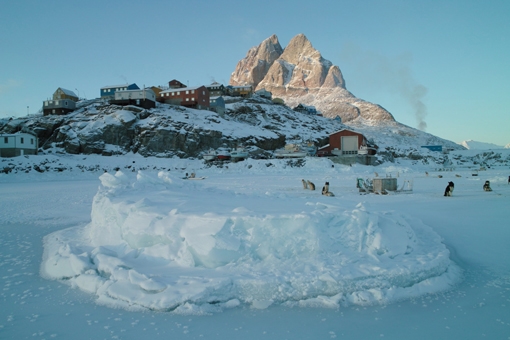
Ummannaq and Hjertefjeldet
The woman in front of me laughs at my bewildered look. “My husband is Ole Jørgen Hammeken. He is friends with your father.”
Soon I am seated across from Ole Jørgen — the man my father calls “The Eskimo Errol Flynn”. The comparison is apt. Ole Jørgen has a stage presence that fills a room. A decade ago, he led my father on an expedition to the northernmost mountain in Greenland, now dubbed Hammeken Point. Ole is the first native Greenlander to be honoured as one the world’s elite explorers.
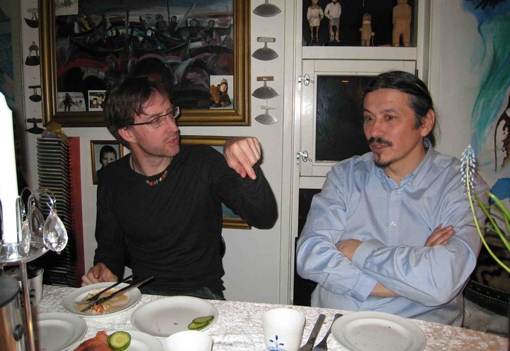
I'm on the left, Ole Jorgen on the right
We laugh at the coincidence — Ole has been to my home thousands of miles away in Gypsum, Colorado, in the heart of the American Rockies. There he ate venison that we harvested from the forest behind our house. Now, totally unplanned, I am seated at his table, eating halibut harvested that morning from beneath the Ummannaq sea ice.
Weeks later, Human Planet takes us to Nepal. It is another place I have never been. Once again, I am greeted with a shock.
“You look like your brother…” muses a Nepali man standing before me. “But he is a strong climber—strong as a Sherpa. Are you?”
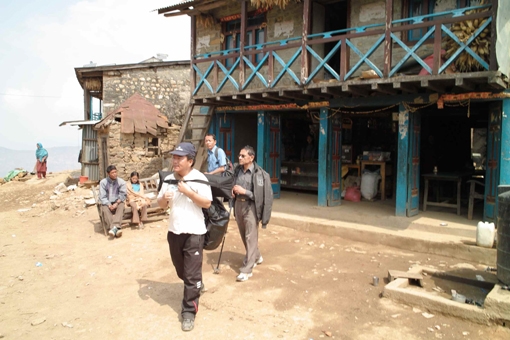
Pemma Sherpa
I stare into the beaming, mischievous smile so characteristic of Nepali Sherpas. A flash of recognition hits me. Put goggles on his eyes, an oxygen mask on his face—yes, it is Pemma Sherpa, who led my brother to the top of Mt. Everest last year. I’ve seen the pictures (it was my brother, Michael Brown’s, fourth successful summit).
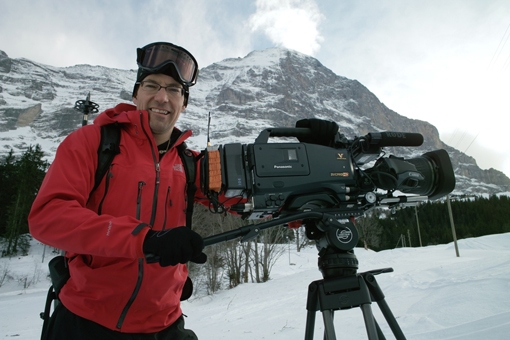
Michael Brown
I can tell that Pemma is going to push me. I’m not the mountaineer my brother is. I curse myself for not training harder for the expedition ahead…
When I started work on Human Planet I knew we would be exploring places I’ve never been before. But I never expected to keep bumping into people I know! In the famous words of my fellow countryman Walt Disney, “It’s a small, small world!”
Dale Templar, Series Producer - Icebreakers
Last week we had unfermented mud in Mali stopping a shoot, this week we’ve had sea ice breaking up far too fast in Greenland. Pushing complex filming trips back at the last minute is not ideal but bringing them forward can be a total nightmare and that’s exactly what it has been. Whether or not you believe the global warming theories, things ain’t what they used to be in the Arctic. One morning last week our “Queen of the Ice”, Bethan Evans got the call she never wanted from North-East Greenland. Overnight a big storm had come across the region and many kilometres of sea ice had been literally blown away - the team had to come and film “now!”, not in four weeks time as planned. With director Nick Brown away in Nepal (see above), the camera crew and safety co-ordinator booked to work elsewhere and flights every two weeks at best, we were starting from scratch. Willow Murton, our assistant producer had to drop the other story she was working on in Siberia and it was Arctic action stations. Somehow, I do not know how , we have an amazing team on location with one of the world’s top Arctic cameramen, Doug Allan. He had another shoot pencilled in for the series Frozen Planet that got cancelled due to weather! How lucky was that?
Blizzards in the bay
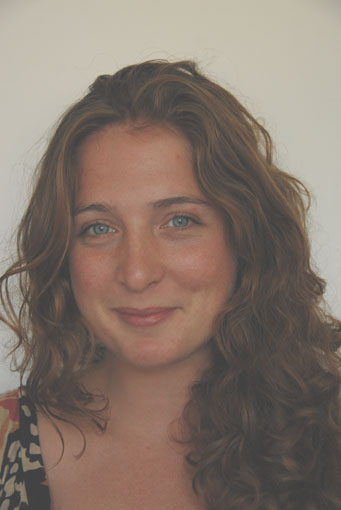
by Willow Murton
Assistant Producer, Arctic/Mountains team
I admit nothing made sense when we arrived over a week ago. Ungava Bay in Northern Canada is set between the jaws of Arctic sea ice. A town on the edge of two worlds – the fast moving skidoo driven modernity onshore and then the timeless pace of the moon, the tides and the unpredictable and volatile seasons beyond. We have come to film a sequence which shows just what dangerous depths people will go to to find food in the unforgiving Arctic winter.
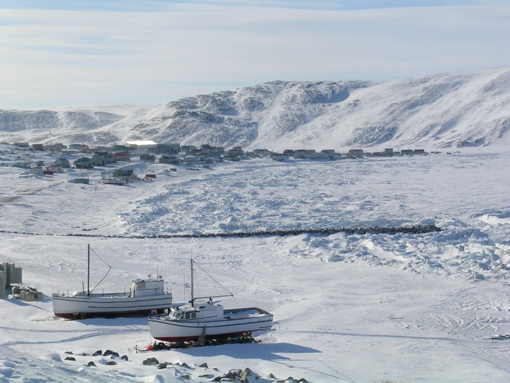
Ungava Bay
As I type now, blizzards have blown into the corners of the windows, against the house steps and the bay is a distant place lost in white. Life here is governed by the weather and so is our filming schedule. We’re staying in the local teacher’s house and I am sitting at the kitchen table whilst in the rooms about me, the crew sleep ahead of the final weekend’s filming. Someone snores in the background. Patrice, our fixer, has pulled the short straw and is laid out on the living room floor in fitful, interrupted sleep in front of me. The storms have blown for two days now, keeping us from the world of sea-ice where our filming sequence takes place. House bound and impatient to return, thick down coats, giant boots and hats are piled expectantly below. Out on the sea ice, our filming kit is buried under snow and somewhere over the other side of the bay, our timelapse camera is hidden in the drifts. We can only wait…
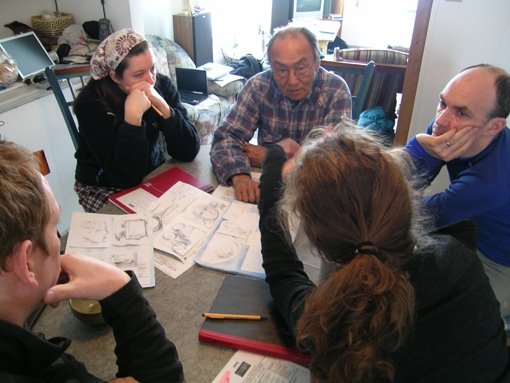
Patience is all important when filming in the Arctic. Everything seems to take twice as long with a film crew and twice as long again in this environment. There are cameras to prepare and to warm up, gloves to find, radios to test, flasks to fill, skidoos to load and then we set off, in a convoy of skidoos, snaking over the frozen bay.
As much as we find ourselves looking on in wonder at the scenes we film, I catch the same curious gaze looking back at us at times. There is no denying it -we are a strange sight.
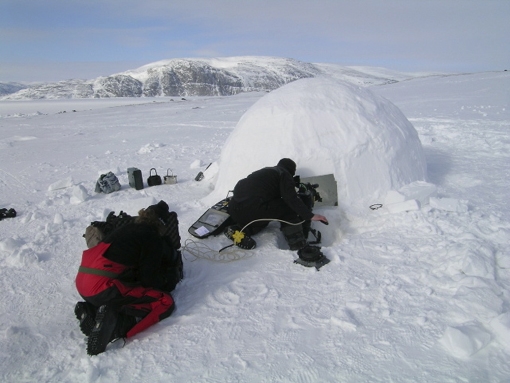
The figure on the left is me!
I wonder what is usual though about this job. Yesterday, Simon, the soundman, and I took advantage of the blizzards to interview our main characters. Lukasi is a small and warm worn-faced man. He has organised our time here with care and attention. He is also keen to talk as are the women we are filming with. They tell us about their lives here, how they have changed so radically from the days of their parents : from the days of igloo dwelling to the building of this modern town. Things are still changing fast, not least the climate. Lukasi wonders whether there will be enough snow here to build igloos in the years to come.
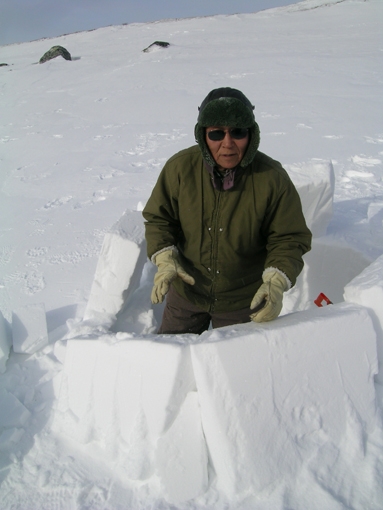
Lukasi building an igloo
These warm-hearted people have welcomed us into their freezing cold world. We have also ventured with them, under the sea-ice itself in what will be a spectacular sequence of daring and drama. What lies out there beyond the sea-ice jaws yet within the grasp of Lukasi and the people who live in this small snow blown town, is an understanding of nature’s forces, generous at times, vicious at others. We have seen but a glimpse – we have a whole year of filming ahead in these Arctic worlds.
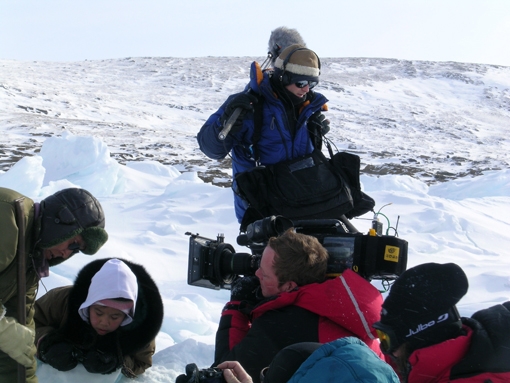
Dale Templar - Series Producer
Mud, mud, not so glorious mud.
Never a day goes by on this series where everything goes to plan. To be honest we would all get bored if it did. It’s always wonderful when we get the teams away on location. The risk assessments are filled in, the camera kit all packed up in lots of silver boxes, and the crew and production team poised like coiled springs. This was the situation last Thursday for the first shoot in our Urban episode. The team were off to Mali to film a mud city being re-plastered. Just as they were about to head off to the airport the researcher, Renee, got a call from the Mali fixer to tell them the mud wasn’t fermented enough to plaster! A two week delay and a huge amount of hassle and disappointment. Mud, mud, not so glorious mud!
Cold hands, crazy cranes and frozen fish

Bethan Evans, Researcher
by Bethan Evans, Researcher, Arctic/Mountains team
As the “cold” researcher for the Arctic programme of Human Planet last month I was lucky enough to find myself in a tiny village on the West Coast of Greenland. With our small crew we were in search of the elusive Greenland shark, known to Greenlanders as Eqalussuaq It’s one of the largest sharks in the world and the only species living in Arctic waters. The Greenland shark lives in deep water, rarely seen near the surface, preferring the frigid cold at depths of up to 2000 metres. As the sea ice melts, local fishermen start seeking it out and we wanted to film their search.
Filming in the Arctic winter is incredibly tough, that’s without the prospect of trying to film an elusive shark that is particularly camera shy! Try passing the cameraman delicate lens tissue and filters while wearing three pairs of gloves. If you do risk taking them off, your fingers freeze to the filters’ cold metal casing.
Or try to keep your crew happy at lunch when their sandwiches have frozen into a solid block!
But throw in a camera crane and an inventive crew and the frozen fun really begins! In order to get some great shots of our fishermen, Amos and Karl-Frederik (a father and son team), we decided to set up the crane over an ice fishing hole. They were busy fishing there for halibut, before turning their attention to sharks.
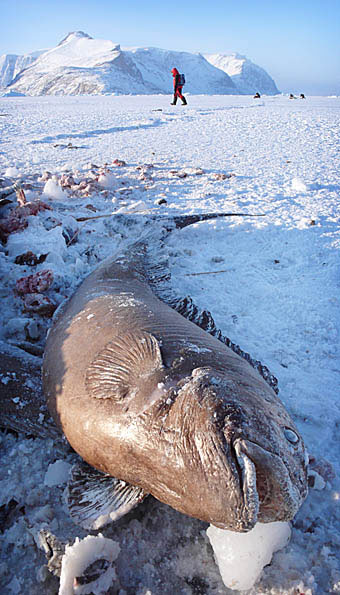
A useful find
The crane works on a counter-balance system so we had planned ahead and hired gym weights from the nearest town. Unfortunately we didn’t have quite enough weight, making the crane difficult to manoeuvre. We scoured the bare, white landscape desperately looking for something to use as a weight. Eventually one of the crew spied a hapless frozen fish which had been lying next to an old fishing hole for days. In Inuit culture every part of a caught animal is used, so in true Arctic spirit we decided this fish would be put to use.
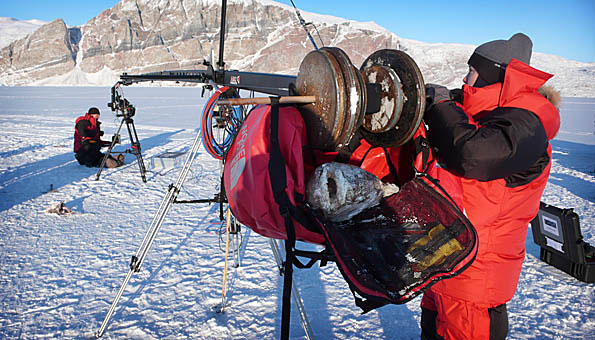
Tipping the balance
The large and quite frankly extraordinarily ugly fish was hauled off the ice and heaved into our medical emergency bag. The bag was emptied of all life-saving equipment to make way for Freddie the Fish. Happily the fish, after a bit of modification, was just the right weight to balance the crane and we carried on filming, much to the amusement of the Greenlandic fishermen.
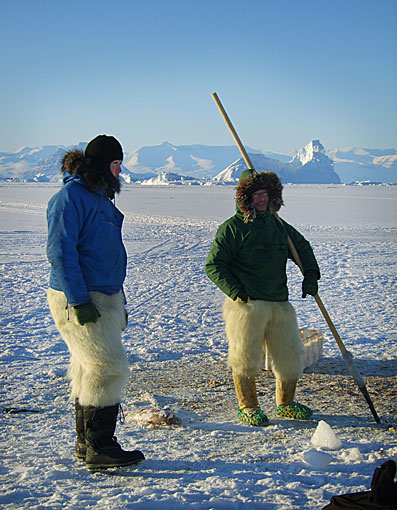
Karl-Frederik and Amos in polar bearskin trousers
…………………………………………………………………………………………………
And finally…..
It’s been another busy month on Human Planet. Our Deserts team are just about to leave for Mali to film a fascinating story about elephants. It is always difficult trying to keep up with the crew in the field in these remote locations . We spend lots of time struggling with Sat phones, as satellites move away and break signal at the crucial moments. “You want a Doctor?…” Crackle , splat…10 minutes later as another satellite cares to drift into sat phone sight lines and we are all ready to contact the BBC Health and Safety Department… “Oh! You want Doctor Who recorded, no worries” . However, when I spoke to director Nick Brown from high in the Ethiopian mountains recently, he sounded as clear as a bell . It must have had something to do with being so close to those satellites!
Dale Templar, Series Producer
Welcome to Human Planet
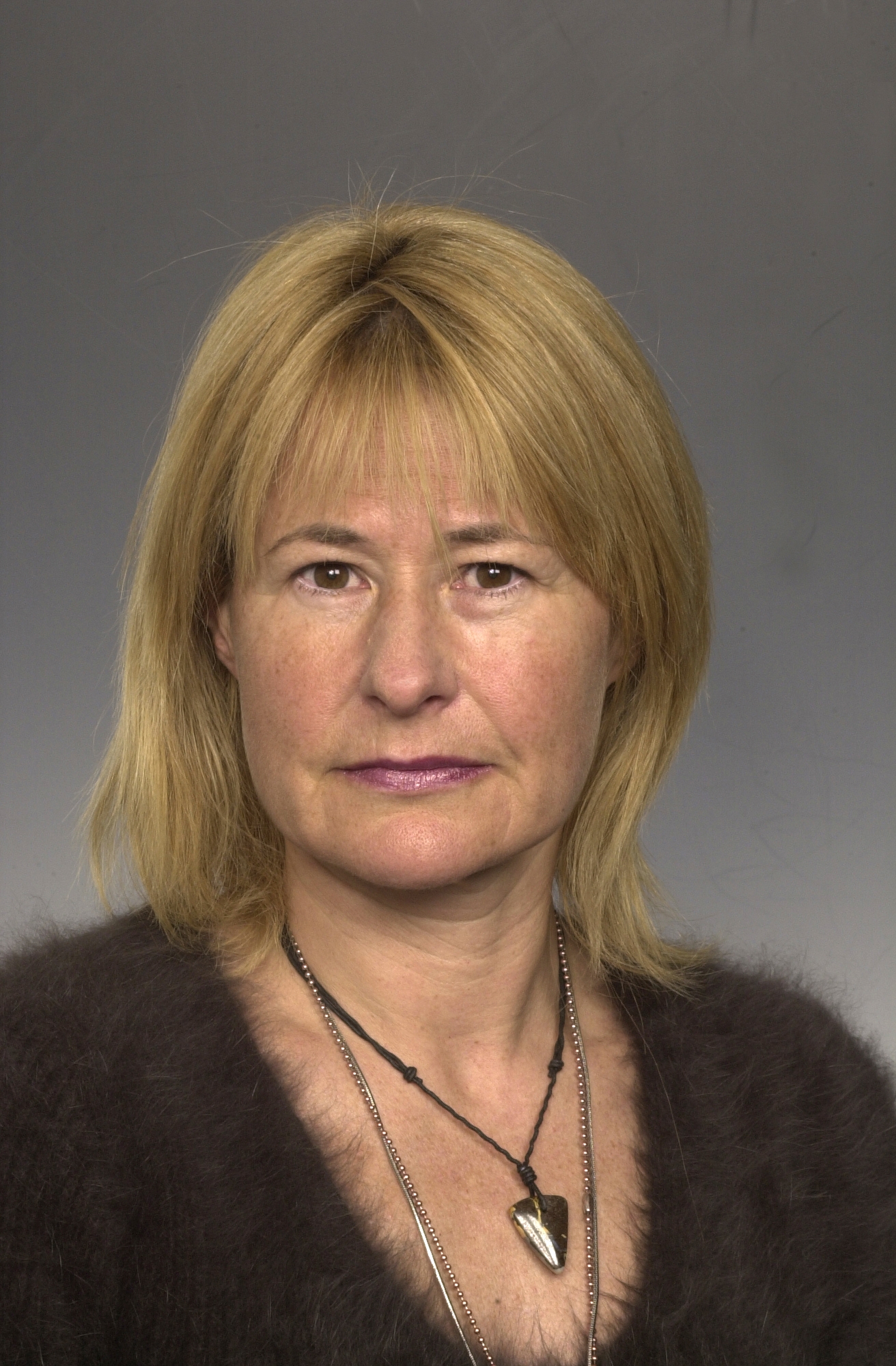
Dale Templar, Series Producer
by Dale Templar, Series Producer
So what is Human Planet? Human Planet is a new 8×50 minute landmark documentary series being made by BBC Television. The series celebrates the human species and looks at our relationship with the natural world by showing the remarkable ways we have adapted to life in every environment on earth. It is due to be transmitted in the UK in the New Year 2011 and will be rolled out across the world soon after.
The production team is split across two sites, one in Bristol and one in Cardiff.
In BBC Bristol we are part of the world renowned Natural History Unit. You may have heard of us, but if not, you’ve probably watched some of our programmes. Many have been presented or narrated by Sir David Attenborough, like Planet Earth and Blue Planet. Most recently we’ve just finished Nature’s Great Events which our own executive producer, Brian Leith, worked on.
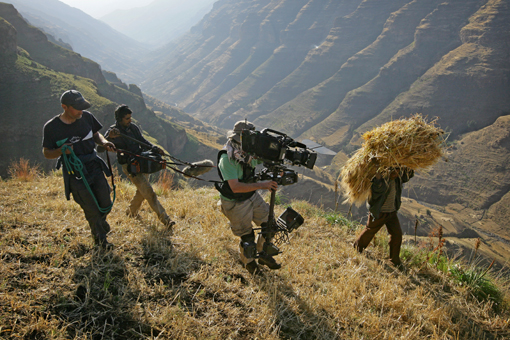
BBC Human Planet : Simien Mountains
BBC Wales, based in Cardiff, are probably best known in the UK right now for producing high end popular dramas like Doctor Who. Torchwood, another sci-fi doc that comes out of Cardiff, is also an HD production and Human Planet will be using the same excellent post-production facilities. The factual department is best known for its ground-breaking anthropology documentary series Tribe.
In total we have a core team of 20 phenomenally talented programme makers, who come with a wide range of skills and experiences. Working with us are some of the best wildlife and documentary camera crews and fixers in the world. For the first time we have a dedicated stills photographer, Timothy Allen, who will be posting his own Human Planet blog every week at http://timothyallen.blogs.bbcearth.com/
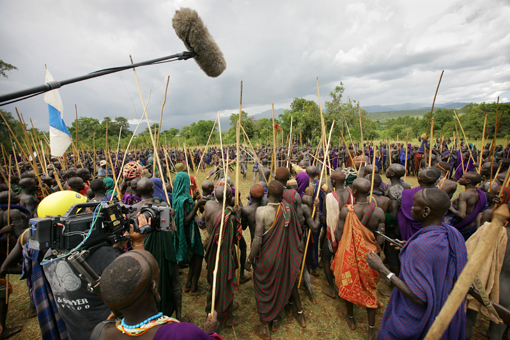
BBC Human Planet : Suri stick fight
The series started in full production in the summer of 2008 and we will be shooting over 70 stories in some of the most remote locations on earth in around 40 different countries.
Each episode will focus on one single environment: desert, jungles, arctic, grasslands, rivers, mountains, oceans and urban. Many of the stories are extremely dramatic and will show how we have successfully adapted and survived in the most challenging places on the planet.
As from next week each member of the team will be blogging their stories from the Human Planet. I will keep you updated on where everyone is and give you general news about the series.
Currently, we have teams that have just come back from the remote southern region of Mongolia, filming for the desert episode. On location are the Jungles and Mountains team who are in the Central African Republic and Nepal. I’ll let you work out which team is where!
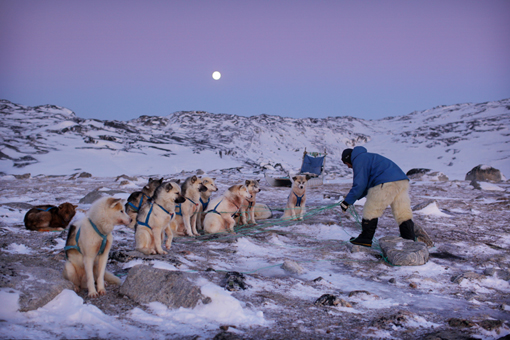
BBC Human Planet : Arctic Dawn
That’s it for now …enjoy the photos and the sneak preview from the series. See the link if you’d like to read what Timothy Allen’s been up to and don’t forget to explore the new BBC Earth site too. Look out for the regular Friday posting from the Human Planet team, with fascinating stories and tales from both our many locations and from the office.
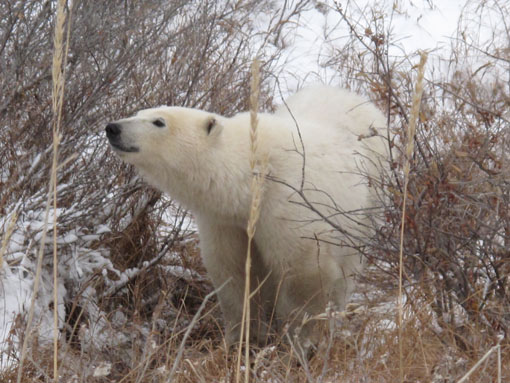
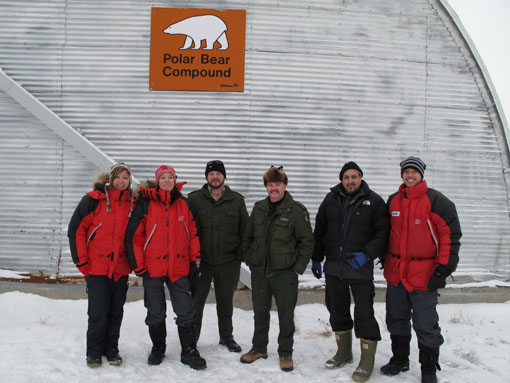
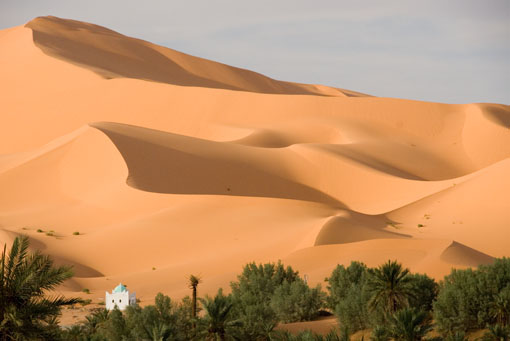
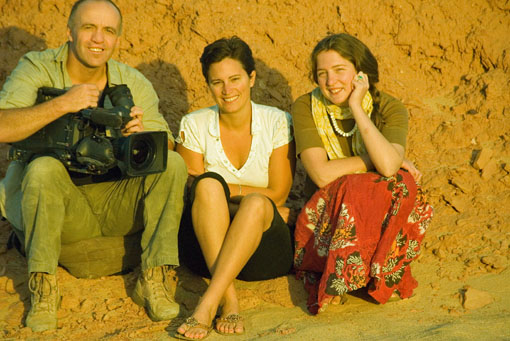
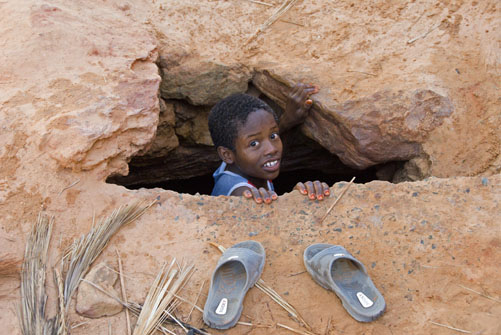

Mr. Hurt, I Presume?
by Dale Templar, Series Producer
John Hurt
When you’ve worked in television for over 20 years you get quite used to meeting and working with famous people. There are very few encounters that have ever really fazed me. One exception was meeting George Michael in a studio at the height of his solo career in the early 90s and, more recently, literally bumping into David Beckham behind the scenes at the O2 in London, with a beefburger in my mouth.
Well, a few weeks ago I was in another recording studio in Hampstead, North London waiting to meet one of our most truly talented British actors. I spotted him as he came through the door of the studio canteen and, as I walked towards him, a vast array of movies and characters flashed before me. Here was “The Elephant Man”, ” The Naked Civil Servant”, Harry Potter’s eccentric wandmaker and finally that stomach bursting scene from “Alien” leapt into my mind! Yes, it can now be officially confirmed that John Hurt is the voice of “Human Planet”. And what a voice! As soon as he shook my hand and said a simple “Hello, nice to meet you”, I just couldn’t wait to start our voice record session.
We spend months in edit cutting the pictures, crafting the films visually but we listen to the programmes with what we call scratch voices on them. At this stage, the script is usually recorded by the episode producer or, sometimes, the picture editor. They always do a great job but when the script is finally locked and we finally get to put on “the voice of the series”, a instant transformation occurs. The narrator gives it a unique identity. John’s resonant, commanding yet warm voice wraps itself around the pictures and draws you into the action and the characters. As I expected John was a consummate professional and we all worked incredibly hard, recording the voice-over for both the Arctic and Oceans episode. This is not an exact science but every line, every word is scrutinized. John had six sets of professional ears, including his own (which was usually the most critical), making sure everything was perfect.
What I loved was John’s dry sense of humour. In the Arctic script we do a scene which is effectively written as a pastiche of a television cookery show, of which we have many in the UK. Here was John Hurt doing his own wonderful interpretation of Delia Smith, or one of that ilk, reading out a recipe for how to prepare Kiviak, a Greenland delicacy, made from unplucked Arctic birds and a sealskin. A classic moment I will never forget.
Aug 20, 2010 | Categories: On Location | Tags: arctic, BBC; Human Planet;, commentary, Dale Templar, Greenland, John Hurt, Kiviak, narrator, oceans | Comments Off